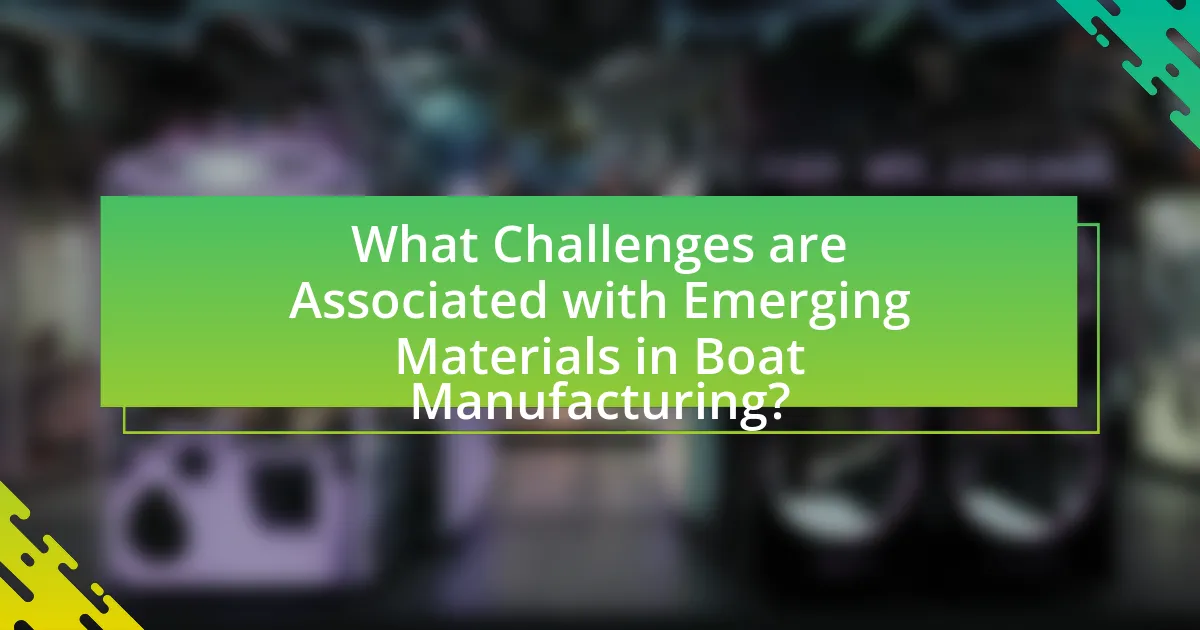Emerging materials in boat manufacturing, including advanced composites, bio-based materials, and nanomaterials, are transforming the industry by enhancing performance, sustainability, and durability. Key properties such as high strength-to-weight ratios and corrosion resistance make these materials superior to traditional options like fiberglass and wood. The article explores how these innovations are reshaping boat design, the environmental benefits they offer, and the challenges manufacturers face in adopting them. Additionally, it highlights current trends, best practices, and the importance of research and collaboration in advancing material technology within the boating sector.

What are Emerging Materials in Boat Manufacturing?
Emerging materials in boat manufacturing include advanced composites, bio-based materials, and nanomaterials. Advanced composites, such as carbon fiber reinforced polymers, offer high strength-to-weight ratios, enhancing performance and fuel efficiency. Bio-based materials, derived from renewable resources, reduce environmental impact while maintaining durability. Nanomaterials, like graphene, improve mechanical properties and corrosion resistance. These materials are increasingly adopted in the industry, driven by the need for lighter, stronger, and more sustainable options in boat design and construction.
How are these materials changing the landscape of boat manufacturing?
Emerging materials such as carbon fiber, advanced composites, and eco-friendly alternatives are revolutionizing boat manufacturing by enhancing performance, reducing weight, and improving sustainability. Carbon fiber, for instance, offers a strength-to-weight ratio that allows for faster and more fuel-efficient vessels, while advanced composites provide durability and resistance to corrosion, extending the lifespan of boats. Additionally, the use of eco-friendly materials, like bio-resins, is addressing environmental concerns, aligning with industry trends towards sustainability. These innovations are not only optimizing manufacturing processes but also meeting consumer demand for high-performance and environmentally responsible products.
What specific properties make these materials suitable for boat construction?
Materials suitable for boat construction possess specific properties such as high strength-to-weight ratio, corrosion resistance, and buoyancy. High strength-to-weight ratio allows for lightweight yet durable structures, enhancing performance and fuel efficiency. Corrosion resistance is crucial for longevity in marine environments, preventing degradation from saltwater exposure. Buoyancy ensures that the vessel remains afloat and stable, contributing to safety and functionality. These properties are validated by the use of advanced composites and alloys, which have been shown to outperform traditional materials in various marine applications.
How do emerging materials compare to traditional boat manufacturing materials?
Emerging materials, such as carbon fiber and bio-composites, offer significant advantages over traditional boat manufacturing materials like fiberglass and wood. These advantages include increased strength-to-weight ratios, enhanced durability, and improved resistance to environmental factors. For instance, carbon fiber is known to be lighter and stronger than fiberglass, allowing for faster and more fuel-efficient vessels. Additionally, bio-composites, made from renewable resources, provide a more sustainable alternative to wood, which is subject to deforestation and environmental degradation. Studies have shown that boats made from these emerging materials can outperform traditional materials in terms of performance and longevity, making them a compelling choice for modern boat manufacturing.
Why is the adoption of new materials important for the boating industry?
The adoption of new materials is crucial for the boating industry because it enhances performance, reduces weight, and improves durability. Advanced materials such as carbon fiber and composite resins allow for lighter and stronger boat designs, which can lead to better fuel efficiency and speed. For instance, the use of carbon fiber can reduce the weight of a vessel by up to 30%, significantly impacting its overall performance. Additionally, innovative materials can offer better resistance to corrosion and environmental factors, extending the lifespan of boats and reducing maintenance costs. This shift towards new materials aligns with industry trends focused on sustainability and efficiency, making it essential for manufacturers to remain competitive.
What environmental benefits do emerging materials provide?
Emerging materials provide significant environmental benefits by reducing resource consumption and minimizing waste. These materials often utilize renewable resources, such as bio-based composites, which decrease reliance on fossil fuels and lower carbon emissions during production. For instance, the use of natural fibers in composite materials can reduce the energy required for manufacturing by up to 50% compared to traditional fiberglass. Additionally, many emerging materials are designed for recyclability, which helps to divert waste from landfills and promotes a circular economy in boat manufacturing. This shift not only conserves natural resources but also mitigates environmental pollution associated with conventional materials.
How do these materials impact the performance and durability of boats?
Emerging materials significantly enhance the performance and durability of boats by providing improved strength-to-weight ratios, corrosion resistance, and flexibility. For instance, advanced composites like carbon fiber and fiberglass reduce weight while maintaining structural integrity, leading to faster speeds and better fuel efficiency. Additionally, materials such as aluminum and high-performance plastics resist corrosion, extending the lifespan of boats in harsh marine environments. Research indicates that boats constructed with these materials can last up to 30% longer than those made with traditional materials, demonstrating their effectiveness in enhancing durability.

What are the Current Trends in Emerging Materials for Boat Manufacturing?
Current trends in emerging materials for boat manufacturing include the increased use of advanced composites, bio-based materials, and 3D printing technologies. Advanced composites, such as carbon fiber reinforced polymers, offer high strength-to-weight ratios and improved durability, making them ideal for performance-oriented vessels. Bio-based materials, derived from renewable resources, are gaining traction due to their lower environmental impact and potential for sustainability in boat production. Additionally, 3D printing is revolutionizing the manufacturing process by enabling rapid prototyping and customization, which enhances design flexibility and reduces waste. These trends reflect a shift towards more sustainable and efficient practices in the boat manufacturing industry.
Which materials are gaining popularity in the industry?
Composite materials, particularly carbon fiber and fiberglass, are gaining popularity in the boat manufacturing industry. These materials are favored for their lightweight properties, strength, and resistance to corrosion, which enhance the performance and durability of boats. According to a report by Grand View Research, the global composite materials market in marine applications is expected to grow significantly, driven by advancements in manufacturing technologies and increasing demand for high-performance vessels.
What are the advantages of using composite materials in boat manufacturing?
The advantages of using composite materials in boat manufacturing include reduced weight, increased strength, and enhanced durability. Composite materials, such as fiberglass and carbon fiber, are significantly lighter than traditional materials like wood or metal, which improves fuel efficiency and speed. Additionally, composites offer superior resistance to corrosion and environmental damage, leading to longer lifespans for boats. For instance, a study by the National Marine Manufacturers Association indicates that boats made from composite materials can last up to 30% longer than those made from conventional materials, demonstrating their effectiveness in enhancing performance and longevity in marine applications.
How is the use of bio-based materials influencing boat design?
The use of bio-based materials is significantly influencing boat design by promoting sustainability and reducing environmental impact. These materials, such as natural fibers and bio-resins, offer lightweight alternatives to traditional composites, enhancing fuel efficiency and performance. For instance, a study published in the Journal of Cleaner Production highlights that bio-composites can reduce the carbon footprint of boat manufacturing by up to 30%. Additionally, the incorporation of bio-based materials allows for innovative design possibilities, enabling manufacturers to create more complex shapes while maintaining structural integrity. This shift towards eco-friendly materials is reshaping industry standards and consumer preferences, driving a trend towards greener boating solutions.
What innovations are driving the development of new materials?
Innovations driving the development of new materials include advancements in nanotechnology, bio-based materials, and additive manufacturing. Nanotechnology enhances material properties such as strength and lightweight characteristics, enabling the creation of composites that are both durable and efficient. Bio-based materials, derived from renewable resources, reduce environmental impact while offering comparable performance to traditional materials. Additive manufacturing, or 3D printing, allows for complex geometries and customized designs, leading to reduced waste and improved material utilization. These innovations are supported by research indicating that the global market for advanced materials is projected to reach $1 trillion by 2025, highlighting the significant impact of these technologies on various industries, including boat manufacturing.
How are advancements in technology contributing to material development?
Advancements in technology are significantly enhancing material development by enabling the creation of lighter, stronger, and more durable materials. For instance, the introduction of advanced composites, such as carbon fiber reinforced polymers, has revolutionized boat manufacturing by reducing weight while increasing strength and resistance to corrosion. According to a study published in the Journal of Composite Materials, the use of carbon fiber composites can reduce the weight of boats by up to 30%, leading to improved fuel efficiency and performance. Additionally, innovations in 3D printing technology allow for rapid prototyping and customization of materials, facilitating the development of complex geometries that were previously unattainable. This technological progress not only accelerates the material development process but also enhances the overall performance and sustainability of boat manufacturing.
What role do research and development play in material innovation?
Research and development (R&D) are crucial for driving material innovation, particularly in the context of boat manufacturing. R&D enables the exploration of new materials and technologies, leading to advancements that enhance performance, durability, and sustainability in boat design. For instance, the development of lightweight composites and bio-based materials has been accelerated through R&D efforts, resulting in boats that are not only more efficient but also environmentally friendly. According to a report by the National Marine Manufacturers Association, innovations in materials through R&D have contributed to a 20% increase in fuel efficiency in modern boats over the past decade. This demonstrates that R&D is essential for fostering innovation that meets both consumer demands and regulatory standards in the marine industry.

What Challenges are Associated with Emerging Materials in Boat Manufacturing?
Emerging materials in boat manufacturing face several challenges, including high costs, limited availability, and regulatory compliance issues. High costs arise from the advanced technology and processes required to produce these materials, such as carbon fiber and advanced composites, which can significantly increase the overall manufacturing expenses. Limited availability is another challenge, as many emerging materials are still in the development phase or produced in small quantities, making them difficult to source consistently. Additionally, regulatory compliance issues can complicate the adoption of new materials, as manufacturers must ensure that these materials meet safety and environmental standards set by governing bodies. These challenges can hinder the widespread adoption of innovative materials in the boat manufacturing industry.
What are the common obstacles faced by manufacturers when adopting new materials?
Manufacturers face several common obstacles when adopting new materials, including high costs, lack of technical knowledge, and regulatory challenges. High costs can deter manufacturers from investing in new materials, as initial expenses for research, development, and production can be significant. Additionally, a lack of technical knowledge among staff can hinder the effective implementation of new materials, as specialized training may be required to understand their properties and applications. Regulatory challenges also pose a barrier, as manufacturers must navigate complex compliance requirements that can vary by region and material type, potentially delaying the adoption process. These obstacles collectively impact the speed and efficiency with which manufacturers can innovate and integrate emerging materials into their production processes.
How do cost factors influence the choice of materials in boat manufacturing?
Cost factors significantly influence the choice of materials in boat manufacturing by determining the overall budget and production feasibility. Manufacturers often prioritize materials that offer a balance between cost-effectiveness and performance, such as fiberglass and aluminum, which are less expensive than traditional wood or high-end composites. For instance, fiberglass is widely used due to its lower material costs and ease of production, allowing for more affordable boat options. Additionally, the total lifecycle cost, including maintenance and durability, plays a crucial role; materials that require less upkeep can be more appealing despite higher initial costs. This economic consideration is supported by industry reports indicating that over 60% of boat manufacturers cite material costs as a primary factor in their material selection process.
What regulatory challenges must be considered with new materials?
Regulatory challenges associated with new materials in boat manufacturing include compliance with safety standards, environmental regulations, and material certification processes. Manufacturers must ensure that new materials meet the requirements set by organizations such as the American Boat and Yacht Council (ABYC) and the International Maritime Organization (IMO), which govern safety and performance standards. Additionally, compliance with environmental regulations, such as the European Union’s REACH (Registration, Evaluation, Authorisation and Restriction of Chemicals) regulation, is crucial to address potential hazards associated with chemical substances in new materials. Furthermore, obtaining certifications for new materials can be a lengthy and costly process, requiring extensive testing and documentation to demonstrate that the materials are safe and effective for use in boat manufacturing.
How can manufacturers overcome these challenges?
Manufacturers can overcome challenges in boat manufacturing by adopting advanced materials and innovative production techniques. Utilizing lightweight composites, such as carbon fiber and fiberglass, enhances performance and fuel efficiency while reducing overall weight. Additionally, implementing additive manufacturing, or 3D printing, allows for rapid prototyping and customization, which can streamline production processes. Research indicates that the use of these materials can lead to a 20-30% reduction in weight compared to traditional materials, significantly improving vessel performance and durability. By investing in training and technology, manufacturers can also ensure their workforce is equipped to handle these emerging materials effectively.
What strategies can be implemented to facilitate the transition to new materials?
To facilitate the transition to new materials in boat manufacturing, companies can implement strategies such as conducting thorough material assessments, investing in training programs, and establishing partnerships with material suppliers. Conducting material assessments allows manufacturers to evaluate the performance, durability, and environmental impact of new materials, ensuring they meet industry standards. Investing in training programs equips employees with the necessary skills to work with innovative materials, enhancing productivity and safety. Establishing partnerships with material suppliers fosters collaboration, enabling manufacturers to stay updated on advancements and best practices in material technology. These strategies are supported by industry trends indicating a shift towards sustainable and high-performance materials in boat manufacturing, as seen in the increasing adoption of composite materials and eco-friendly alternatives.
How can collaboration within the industry help address material challenges?
Collaboration within the boat manufacturing industry can significantly address material challenges by facilitating knowledge sharing and resource optimization. When companies work together, they can pool their expertise to develop innovative materials that enhance performance and sustainability. For instance, joint research initiatives can lead to breakthroughs in composite materials that are lighter and more durable, directly addressing issues like weight reduction and longevity in boat design. Additionally, collaborative efforts can streamline supply chains, reducing costs and improving access to high-quality materials. This approach has been evidenced by partnerships in the aerospace sector, where collaborative research has led to the development of advanced lightweight materials, showcasing the potential benefits for the boat manufacturing industry as well.
What Best Practices Should Manufacturers Follow When Using Emerging Materials?
Manufacturers should prioritize thorough research and testing when using emerging materials to ensure performance and safety. This involves conducting material compatibility assessments, evaluating mechanical properties, and understanding environmental impacts. For instance, the use of advanced composites in boat manufacturing requires manufacturers to test for durability and resistance to marine conditions, as evidenced by studies showing that composite materials can significantly enhance the lifespan of vessels compared to traditional materials. Additionally, manufacturers should stay updated on regulatory standards and industry best practices to ensure compliance and optimize material selection for sustainability and efficiency.
How can manufacturers ensure quality and safety in using new materials?
Manufacturers can ensure quality and safety in using new materials by implementing rigorous testing protocols and adhering to industry standards. These protocols include mechanical testing, chemical analysis, and environmental assessments to evaluate the performance and safety of materials under various conditions. For instance, the American Boat and Yacht Council (ABYC) provides guidelines that manufacturers can follow to ensure compliance with safety standards. Additionally, manufacturers should engage in continuous monitoring and feedback loops during production to identify any potential issues early. This proactive approach not only enhances product reliability but also aligns with regulatory requirements, thereby safeguarding both the manufacturer and the end user.
What are the key considerations for maintenance and repair of boats made with emerging materials?
Key considerations for maintenance and repair of boats made with emerging materials include understanding the specific properties of the materials used, ensuring compatibility with repair products, and employing specialized techniques for maintenance. For instance, composite materials like carbon fiber and fiberglass require different adhesives and repair methods compared to traditional wood or metal. Additionally, emerging materials may have unique susceptibility to environmental factors, necessitating regular inspections for signs of wear or damage. Research indicates that improper maintenance can lead to significant degradation of these materials, emphasizing the need for tailored maintenance protocols that reflect their distinct characteristics.





